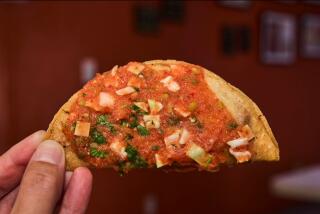The Tortilla Life
Maiz o harina? Corn or flour? To this perennial question, one that can sometimes denote the character of a man--would a true Mexican ever turn down a freshly made corn tortilla?--most members of my family usually answer âflour.â
In our family, corn tortillas came from the supermarket, but flour tortillas have always been made fresh by my grandmother whenever weâve gotten together. It is her I think of whenever I eat a well-made one, and her I still go to for tortilla advice.
As she works her strong hands into a mass of tortilla dough, I daydream about the future, when my daughter will be old enough to understand the tortilla lessons demonstrated by my grandmother almost daily before her big, happy eyes.
I ask my grandmother why it is that she always makes flour tortillas, never corn.
âBecause theyâre the worst for you,â she says with a wink. âI donât know why,â she goes on, âbut somehow the things that are bad for you are the ones we like the most.â
With her grip firm on the dough, she swipes the sides of the bowl clean of flour and says, â Ay mia , you know most of the time I donât use oil or lard in my tortillas. Theyâre fattening that way.â
Instead, my grandmother has devised a trick for making tortillas without adding much fat at all: She rubs her hands with a little vegetable oil, as if she were applying some lovely perfumed lotion, then sets about kneading her dough.
âOf course, they taste best with lard,â she says, a hint of sadness in her voice. âCrisco is excellent too.â On certain special occasions, she will fatten up her tortillas, but this morning, for an ordinary breakfast, itâs best to be prudent.
Now my grandmother takes the dough and squeezes a small bit through her fist. In an instant, sheâs got a small army of dough balls, each miraculously the same size and ready for shaping. With a quick two-handed motion that resembles something you might do if you were having trouble opening a tightly shut jar, she flattens the underside of each piece of dough while simultaneously guiding the ball in a circle, as if it were a teeny steering wheel. âYou want to make sure you flatten the edges,â she explains. âThe center, you never have to worry about.â
When sheâs worked through each piece of dough, she drapes a kitchen towel over everything and says, âNow we let them rest.â
As she rests, my grandmother tells me how she remembers watching--and asking to help--her mother make tortillas every morning. âShe used to grind the corn herself to make the dough,â my grandmother says. But itâs her motherâs flour tortillas that stir her memory.
âI remember one day when my mother got sick and my father made tortillas for us. He went into the kitchen. He rolled up his sleeves. He washed his hands, his face and his arms, and he made flour tortillas. I was 3 years old and I was so proud of him. I mean, he was so used to having everything done for him. When he would wash, my mother would have the water ready for him and she would stand there with a towel, waiting for him to finish so she could hand it to him. Thatâs the way women were in those days.â
When my grandmother married my grandfather here in Los Angeles she almost always made flour tortillas for him. âBecause by then,â my grandmother says, âthatâs what my mother made and thatâs what his mother made. Thatâs what we all preferred.â
My grandfather must have approved--right after they were married, he made my grandmother her own rolling pin, especially for tortillas. âOh, Iâve had this since I was 18,â she says as she briskly rolls a piece of dough into a tortilla. âIn fact he made two for me, just in case I lost one. Of course, I never did.â
She slaps the rolled tortilla back and forth a few times between her hands, then lays it on the black iron griddle that has been warming since she started the dough.
âI suppose you donât really have to pat flour tortillas,â she says. âItâs kind of an old habit, something that you do a lot with corn tortillas to stretch them. But even with flour, itâs good to let the tortillas stretch out a little more.
âYou know,â she says, warmed up, ready to bestow upon her granddaughter once more the kitchen tips sheâs been teaching for years, âif the tortilla starts to puff up as it cooks, you can press it down with a kitchen towel. Thatâs just something we always used to do.â
With the tips of her fingers, she lifts the tortilla off the griddle and onto my plate. âWhen youâve been making tortillas awhile,â she says, âyou can stand the heat.â
FLOUR TORTILLAS
3 cups flour
1 teaspoon baking powder
3/4 teaspoon salt
3 tablespoons vegetable shortening, lard or oil, optional
About 1 cup lukewarm water
Mix flour, baking powder and salt together in mixing bowl. Blend in shortening. Gradually stir in water until crumbly dough forms. Work dough with hands until dough holds together. Shape into ball on floured board. Knead ball of dough until smooth.
Divide dough into 12 equal parts. Cover. Let stand 15 minutes. Flatten each part to about 4-inch circle. Roll into 8-inch circle with rolling pin. Cook on hot, ungreased griddle or comal.
Makes 12 tortillas.
Each tortilla, without shortening, contains about:
105 calories; 183 mg sodium; 0 mg cholesterol; 0 grams fat; 22 grams carbohydrates; 3 grams protein; 0.09 grams fiber.
Each tortilla, with shortening, contains about:
135 calories; 183 mg sodium; 0 mg cholesterol; 4 grams fat; 22 grams carbohydrates; 3 grams protein; 0.09 grams fiber.
Roll âEm Out
1. Squeeze off a portion of dough by making a fist. The dough should form a rough ball as you pull it from your hand. When the dough is divided, pre-shape the dough balls. Place the fingertips of one hand underneath the piece of dough and press in the sides of the ball to flatten it while simultaneously guiding the ball in a circle with your other hand, as if you were guiding a steering wheel during a slow turn. Cover and let the dough stand about 15 minutes.
2. Roll each ball of dough into a flat circle using a rolling pin. After each pass with the rolling pin, lift the dough and turn it a few degrees clockwise to ensure an even thickness.
3. Pat a tortilla back and forth between both hands a few times, as if you were rhythmically clapping and flipping your wrists simultaneously. The tortillas will stretch some and become slightly wider.
4. Place the tortilla on a hot griddle or comal . Let one side cook, then flip the tortilla. If the tortilla starts to puff up, press down on the tortilla with a thick dish towel.
caption
More to Read
Eat your way across L.A.
Get our weekly Tasting Notes newsletter for reviews, news and more.
You may occasionally receive promotional content from the Los Angeles Times.











